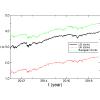当前位置:
X-MOL 学术
›
Phys. Rev. E
›
论文详情
Our official English website, www.x-mol.net, welcomes your
feedback! (Note: you will need to create a separate account there.)
Stock markets: A view from soft matter
Physical Review E ( IF 2.2 ) Pub Date : 2020-03-17 , DOI: 10.1103/physreve.101.032307 Antonio M. Puertas , Miguel A. Sánchez-Granero , Joaquim Clara-Rahola , Juan E. Trinidad-Segovia , F. Javier de las Nieves
Physical Review E ( IF 2.2 ) Pub Date : 2020-03-17 , DOI: 10.1103/physreve.101.032307 Antonio M. Puertas , Miguel A. Sánchez-Granero , Joaquim Clara-Rahola , Juan E. Trinidad-Segovia , F. Javier de las Nieves

|
Different attempts to describe financial markets, and stock prices in particular, with the tools of statistical mechanics can be found in the literature, although a general framework has not been achieved yet. In this paper we use the physics of many-particle systems and the typical concepts of soft matter to study two sets of US and European stocks, comprising the biggest and most stable companies in terms of stock price and trading. Upon correcting for the center-of-mass motion, the structure and dynamics of the systems are studied (in the European set, the structure is studied for the UK subset only). The pair distribution of the stocks, corrected to account for the nonuniform distribution of prices, is close to 1, indicating that there is no direct interaction between stocks, similar to an ideal gas of particles. The dynamics is studied with the mean-squared price displacement (MSPD); the price correlation function, equivalent to the intermediate scattering function; the price fluctuation distribution; and two parameters for collective motions. The MSPD grows linearly and the velocity autocorrelation function is zero, as for isolated Brownian particles. However, the intermediate scattering function follows a stretched exponential decay, the fluctuation distributions deviate from the Gaussian shape, and strong collective motions are identified. These results indicate that the dynamics is much more complex than an ideal gas of Brownian particles, and similar, to some extent, to that of undercooled systems. Finally, two physical systems are discussed to aid in the understanding of these results: a low density colloidal gel, and a dense system of ideal, infinitely thin stars. The former reproduces the dynamical properties of stocks, linear mean-squared displacement (MSD), non-Gaussian fluctuation distribution, and collective motions, but also has strong structural correlations, whereas the latter undergoes a glass transition with the structure of an ideal gas, but the MSD has the typical two-step growth of undercooled systems.
中文翻译:

股票市场:从软物质看
尽管尚未建立一个通用的框架,但在文献中可以找到用统计力学的工具描述金融市场,尤其是股票价格的不同尝试。在本文中,我们使用多粒子系统的物理学原理和软物质的典型概念来研究两组欧美股票,其中包括股票价格和交易方面最大和最稳定的公司。校正质心运动后,将研究系统的结构和动力学(在欧洲范围内,仅针对英国子集研究结构)。经校正以解决价格不均匀分布的股票对对分布接近于1,这表明股票之间不存在直接相互作用,类似于理想的粒子气体。用均方价格位移(MSPD)研究动力学。价格相关函数,相当于中间散射函数;价格波动分布;和两个集体运动参数。对于孤立的布朗粒子,MSPD线性增长,速度自相关函数为零。但是,中间散射函数遵循拉伸的指数衰减,波动分布偏离高斯形状,并且可以识别出强烈的集体运动。这些结果表明,动力学比布朗粒子的理想气体复杂得多,并且在某种程度上类似于过冷系统。最后,讨论了两个物理系统以帮助理解这些结果:低密度胶体凝胶和理想的致密系统,无限稀薄的星星。前者再现了股票的动力学特性,线性均方位移(MSD),非高斯涨落分布和集体运动,但具有很强的结构相关性,而后者则经历了理想气体结构的玻璃化转变,但是MSD具有过冷系统的典型两步式增长。
更新日期:2020-03-19
中文翻译:

股票市场:从软物质看
尽管尚未建立一个通用的框架,但在文献中可以找到用统计力学的工具描述金融市场,尤其是股票价格的不同尝试。在本文中,我们使用多粒子系统的物理学原理和软物质的典型概念来研究两组欧美股票,其中包括股票价格和交易方面最大和最稳定的公司。校正质心运动后,将研究系统的结构和动力学(在欧洲范围内,仅针对英国子集研究结构)。经校正以解决价格不均匀分布的股票对对分布接近于1,这表明股票之间不存在直接相互作用,类似于理想的粒子气体。用均方价格位移(MSPD)研究动力学。价格相关函数,相当于中间散射函数;价格波动分布;和两个集体运动参数。对于孤立的布朗粒子,MSPD线性增长,速度自相关函数为零。但是,中间散射函数遵循拉伸的指数衰减,波动分布偏离高斯形状,并且可以识别出强烈的集体运动。这些结果表明,动力学比布朗粒子的理想气体复杂得多,并且在某种程度上类似于过冷系统。最后,讨论了两个物理系统以帮助理解这些结果:低密度胶体凝胶和理想的致密系统,无限稀薄的星星。前者再现了股票的动力学特性,线性均方位移(MSD),非高斯涨落分布和集体运动,但具有很强的结构相关性,而后者则经历了理想气体结构的玻璃化转变,但是MSD具有过冷系统的典型两步式增长。











































 京公网安备 11010802027423号
京公网安备 11010802027423号